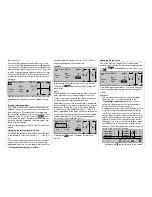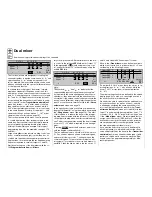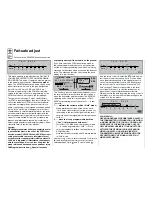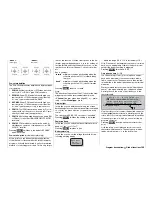
151
151
Program description:
Special functions
Model name
#01 0:30h SPCM20
H-J.Sandbrunner
10.2V
0:30h
0
0
0
0
Stop watch
Flight tim
0 00
0 00
:
:
DSC
The control functions you wish to transfer MUST
act directly on the control channels, i. e. the recei-
ver outputs, without the involvement of any type
of mixer.
If you are using an
mc
-series or
mx
-series trans-
mitter, it is best to activate a free model memory and
use that memory in its base setting, with the approp-
riate model type (“Fixed-wing” or “Helicopter”) selec-
ted. Assign the name “Pupil” to this memory, and set
up the stick mode (Mode 1 … 4) and “Throttle forward
/ back” to suit the pupil’s preference. Leave all other
settings at the basic default values. If you have se-
lected the “Helicopter” model type, you must also set
the throttle / collective pitch direction and idle trim on
the Pupil transmitter. All other settings, including mi-
xer and coupling functions, are entered exclusively at
the Teacher transmitter, which in turn transfers them
to the model.
With “
D
” and “
FM
” type transmitters you must also
check the direction of servo rotation and stick mode,
and make corrections if necessary by re-connecting
the leads inside the transmitter. All other mixers must
be switched off or set to “zero”.
When assigning the control functions the usual con-
ventions must be observed:
Channel
Function
1
Throttle / Collective pitch
2
Aileron / Roll
3
Elevator / Pitch-axis
4
Rudder / Tail rotor
If you wish to be able to transfer auxiliary control
functions to the Pupil transmitter as well as the func-
tions of the two dual-axis sticks (1 … 4), move to the
»
Transmitter control adjust
« of the Pupil transmitter
and assign transmitter controls to those inputs which
correspond to the transmitter control numbers 4 …
10 which are to be transferred. In the above example
– control of camber-changing fl aps using transmitter
control 9 – an (unused) transmitter control should be
assigned at the Pupil transmitter to “Input 9”. At the
Pupil transmitter you can even assign an (external)
switch, if the Pupil transmitter offers this facility. Ho-
wever, in this case the relevant function can only be
switched between two or three positions, e. g. for swit-
ching a motor on and off. (If you neglect to assign a
transmitter control at the Pupil transmitter, the corre-
sponding control signal remains in its centre position
when control is transferred to the Pupil transmitter.)
Trainer mode operations
Link the two transmitters using the appropriate lead
(see summary in the right-hand column): the plug
marked “
M
” (Master) must be inserted in the socket
on the Teacher transmitter, and the plug marked “
S
”
(Student) in the Pupil transmitter’s socket.
Important note:
The ends of the Trainer lead you are using are
marked “S” or “M”; they can be identifi ed by the
three-pole barrel plugs. On no account connect
one of these to a DSC system socket, as it is not
suitable for this application.
Checking the system
Operate the Trainer switch you have assigned:
• If the Trainer system is working correctly, the dis-
play changes from “
T” to “
P”.
• If you see the following warning message …
… both in the “Trainer” menu and in the basic dis-
play, and the screen shows “-P” on the left of the
“Trainer” menu, then there is a problem in the link
between the Pupil transmitter and the Teacher
transmitter; you will also be alerted to the problem
by an audible warning. If this should happen, all
functions are transferred automatically to the Tea-
cher transmitter regardless of the switch position,
to ensure that the model is never out of control.
Possible faults:
• Interface in Pupil transmitter not connected cor-
rectly in place of the RF module
• Pupil transmitter not ready for use
• Pupil transmitter not set to PPM mode
• Light-pipe not connected properly
• Light-pipe lead loose in plug:
If this should happen,
press lightly on the end
of the connector (1) to re-
lease the light-pipe clamp
mechanism in the “S” or
“M” connector, then push
the light-pipe lead (2) in as
far as it will go.
In later versions of the sys-
tem the light-pipe lead is
secured by a crimped screw
arrangement.
Check that there is no dirt
or dust in the openings of
the light-pipe.
• Incorrect cable connection: select the appropriate
lead from the table on the next page.
2
1
No
pupil
signal
Summary of Contents for mx-24s
Page 1: ...1...
Page 19: ...19 For your notes...
Page 35: ...35 For your notes...
Page 41: ...41 41 For your notes...
Page 57: ...57 For your notes...
Page 63: ...63 63 For your notes...
Page 69: ...69 69 For your notes...
Page 85: ...85 85 For your notes...
Page 99: ...99 For your notes...
Page 143: ...143 For your notes...
Page 191: ...191 For your notes...
Page 212: ...212 212 For your notes...
Page 213: ...213 213 For your notes...
Page 214: ...214 For your notes...
Page 216: ...216...
















































